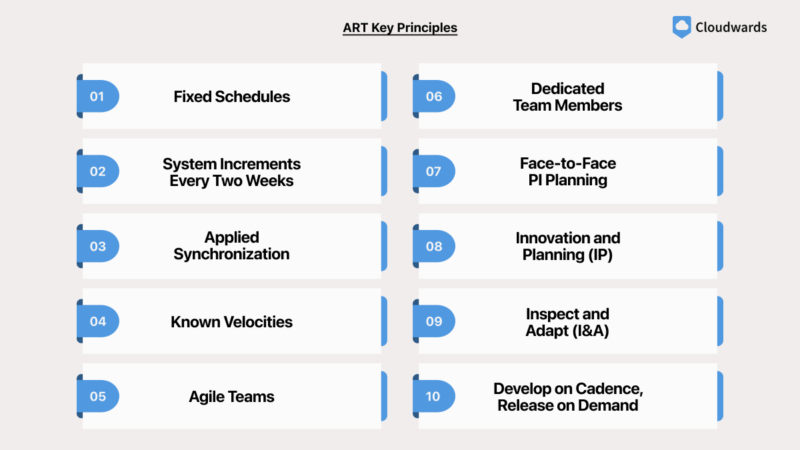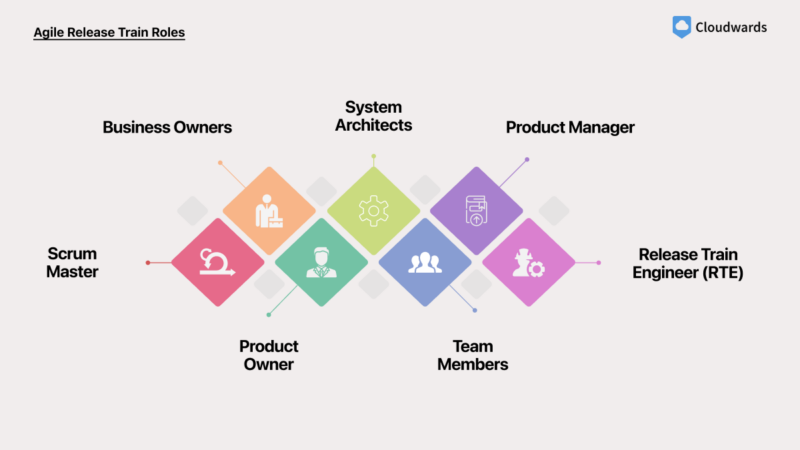What Is an Agile Release Train? 2025 ART Guide
If you’re looking to become part of a SAFe scaled agile team -- also known as an agile release train (ART) -- but want to understand what an ART is before you start, don’t miss our beginners guide to all things agile release train.
If you’ve been around small businesses and agile frameworks like scrum, you’ll know the teams are small. However, as companies grow and demands increase, the need for multiple teams that can work on projects together increases. A scaled agile solution like SAFe, which uses an agile release train (a team of agile teams) that works together on one project, is a great option.
SAFe and scrum are quite similar, with many agile principles used in both. In fact, they’re so similar that project management software like monday dev — a sibling of monday.com, the best agile tool — can easily be used to manage multiple teams working on scaled projects.
In this guide, we’ll clue you in on all things related to agile release trains (ARTs). You’ll learn what an ART is, what its key characteristics and principles are, and the roles within an ART. We’ll also teach you the benefits of using a scaled agile solution. ARTs sound complicated, but trust us; you’ll be an ART expert by the time you’re done reading this. Let’s get started.
-
05/21/2024
Updated the article to add custom graphics.
What Is an Agile Release Train (ART)?
An agile release train (ART), which is fundamental to SAFe (scaled, enterprise-level teams), is a team composed of multiple agile teams (five to 12) working toward one common organizational goal. ART teams, which are known as a virtual organization, can contain 50 to 125 team members.
Avoid Costly Project Management Mistakes – Get Free Tips Today!

- Discover 10 fundamentals of project management
- Understand step-by-step plans for PM execution
- Learn tips to avoid 5 common mistakes by beginners

All ART teams have the necessary employees, including a scrum master, a product owner and a development team, to implement, test, release and deploy software or any other product type. An agile RTE (release train engineer) leads ARTs and acts as the lead scrum master. To be successful, agile teams must be self-organizing and work well together.
ART Characteristics
The main goal of using ARTs is to promote connections between teams working on various parts of one company-wide project. The collaborations that ensue between teams help shed light on project progress and build relationships between cross-functional teams. To be successful, ART teams should be:
- Autonomous: An agile team must be a self-organizing group that can work autonomously to continually deliver products and business value.
- Stable: An ART team should contain seasoned employees who have worked with each other over a significant period of time. Stable teams that work together long term promote growth and trust, which can improve work efficiency.
- Collaborative: Creating a product using multiple agile teams requires a large collaborative effort across various departments.
ART Key Principles
Like other frameworks, SAFe has a set of common principles that all ART teams follow. Below, we’ll explain each of the principles.

Fixed Schedules
Agile release trains deliver work on a fixed schedule, which the organization’s program increment (PI) cadence determines. PIs, which are similar to sprints in the scrum framework, last eight to 12 weeks and contain multiple sprints that last between one and four weeks each. Like sprints, user stories not included in a program increment cannot be started until the next PI.
System Increments Every Two Weeks
In the SAFe framework, agile release trains roll out new system increments every two weeks. The idea is to release a system demo every two weeks to see how the product is progressing.
Applied Synchronization
All agile release train teams are synchronized to the same program increment (PI). The synchronization ensures that all teams have the same schedule with the same start and end dates; this way, multiple teams can showcase their work on the same system demo dates.
Known Velocities
Thanks to reports that can be found in many of the best project management software options, agile RTEs can estimate how much work an agile release train can complete in one program increment. With known velocity data, product managers can set appropriate team workloads.
Agile Teams
Agile teams are a critical component of agile release trains. You can read more about agile teams in our “What is Agile?” guide, but for now, agile teams take the agile manifesto and its principles and guidelines to heart. They are generally well versed in agile frameworks like kanban and scrum, and they can work autonomously.
Dedicated Team Members
One of the characteristics of ARTs is stability. In order to maintain stability, it’s essential to have dedicated team members who work full-time, remain part of the same team and have extensive experience.
Face-to-Face PI Planning
A vital part of any agile methodology is face-to-face meetings, which is true for the SAFe framework, too. Agile release train teams determine the work to be included in upcoming program increments by talking about it in person or via remote conferencing software if teams are distributed. These meetings are similar to sprint planning sessions in scrum.
Innovation and Planning (IP)
When a PI is finished, agile release trains hold innovation and planning sessions. These meetings, which are similar to sprint retrospective meetings, are the ideal time to celebrate wins and losses, discuss what did and didn’t work, hold education sessions and engage in change management discussions.
Inspect and Adapt (I&A)
During inspect and adapt sessions (I&A), the products developed during the program increments are demoed and evaluated. I&A meetings are also the ideal time to identify improvement backlog items via a problem-solving workshop.
Develop on Cadence, Release on Demand
ART teams split development and release schedules, as they need to account for the variability of developing new products from scratch. Still, teams are free to release software that shows value to the customer at any time as long as it meets any governance or release criteria that may have been set.
Agile Release Train Roles
As you can imagine, a framework as complex as SAFe, with its agile release trains, needs many roles to be filled for project success. Below, we’ll list and explain the most common roles you can expect to find in ART teams.
- Release train engineer: The role of the servant leader, or, as they’re more commonly known, the release train engineer, is vital in SAFe. RTEs are responsible for project execution and tracking, risk management and problem-solving.
- Product manager: The product manager is responsible for the final product and communication with internal and external stakeholders.
- Business owners: These internal stakeholders are responsible for the project’s outcome.
- Scrum master: The scrum master on each team guides team members, holds meetings, monitors output and ensures best practices are followed at all times.
- Product owner: The PO is responsible for managing the user story backlog for their agile team and providing value to the client.
- Team members: Most cross-functional ART teams will be made up of team members. Team members work on user stories during program increments.
- System architects: System architects play a key role in defining major system elements, from system architecture to interfaces, and making sure they play together nicely.

What Is the Purpose of Agile Release Trains?
Implementing agile release trains can be beneficial in many ways. Below, we’ll list five reasons why you might want to consider using ARTs.
Better Work Planning
The structure of ART teams, with their many leaders and well-defined PI planning meetings, I&As and IPs, allows agile teams to better plan workloads, set goals that will lead to positive client outcomes and reflect on past and future work. Face-to-face meetings also build trust, create stability and encourage autonomy, as teams are given information upfront.
Improved Customer Relations
Like any agile project management methodology, communication is at the forefront of everything ART teams do. Because ART teams champion communication, the customer is one of the main beneficiaries of SAFe and ART teams.
Open, transparent communication between leaders and stakeholders builds trust, opens doors for feedback and allows key internal and external stakeholders to become involved in the development process.
Increased Customer Value
Thanks to the structure of SAFe and ARTs in general, agile teams can work at a consistent pace (cadence) and release a new system increment regularly, enabling clients to see the increased value of the release software or product more frequently.
Enhanced Collaboration and Communication
As you can imagine, having multiple ARTs working on one project across an entire organization will improve collaboration and communication not only between teams but also between senior leaders, key stakeholders and clients, as feedback and input will be free-flowing.
Continually Evolving Teams
Another key benefit of agile release trains is continually evolving or improving teams. By measuring known velocities and holding agile release train events (meetings), managers and teams can share and analyze a continual flow of information, including performance metrics.
Thanks to the adaptability of agile teams, processes can be improved and continuing education classes can be held to help team members learn new skills. In the long run, in-person meetings can help improve team performance during future projects.
Final Thoughts
We hope our beginner guide to agile release trains and how they fit into the SAFe agile framework has been beneficial. As you can tell, SAFe is similar to scrum and uses many of the same agile practices to get work done. The only difference is that it’s scaled over multiple teams (ARTs) working on one enterprise-wide project.
If you understand scrum, you’ll have no problems with SAFe or ARTs once you master the terminology. Have you been part of an ART before? What role did you play? Have we missed anything in our guide that would be beneficial to our readers? Let us know in the comments. Thanks for reading.
FAQ: What Is an Agile Release Train?
A sprint is a measured work period in the scrum framework that lasts one to four weeks. An agile release train is a team of agile teams working collectively on a large project.
In scrum, scrum masters are responsible for leading meetings, managing small teams, managing risk and championing a collaborative environment. An RTE plays a similar role in SAFe, but instead of leading a team of developers, the RTE leads a team of scrum masters, who in turn lead the many teams that make up an agile release train.
An agile release train is the primary value delivery method in the SAFe framework, and it is a group of five to 12 self-organizing agile teams that plan and execute a project together.


